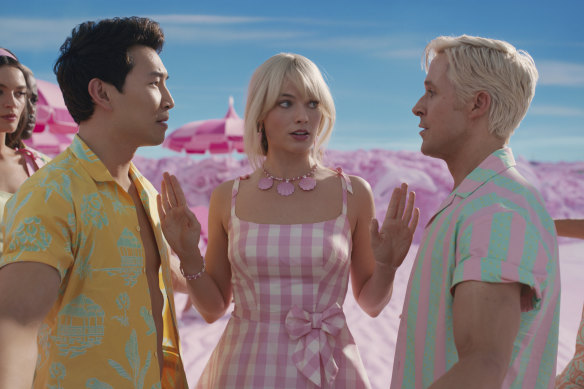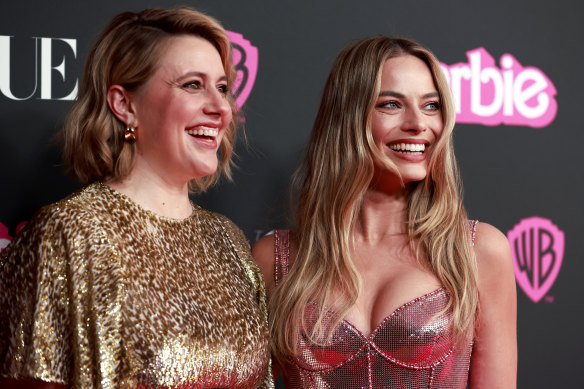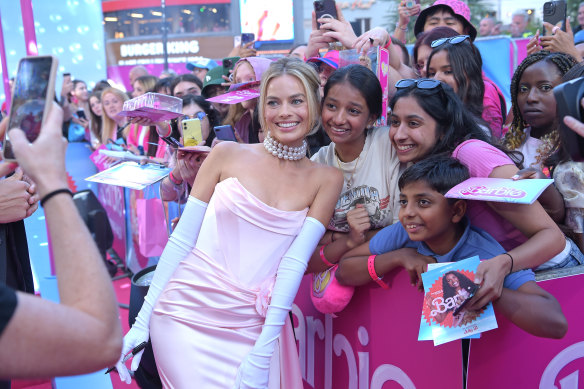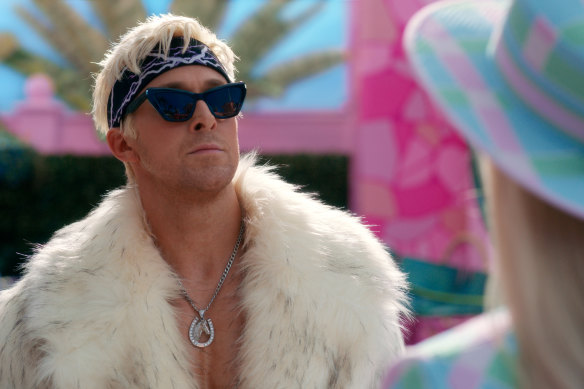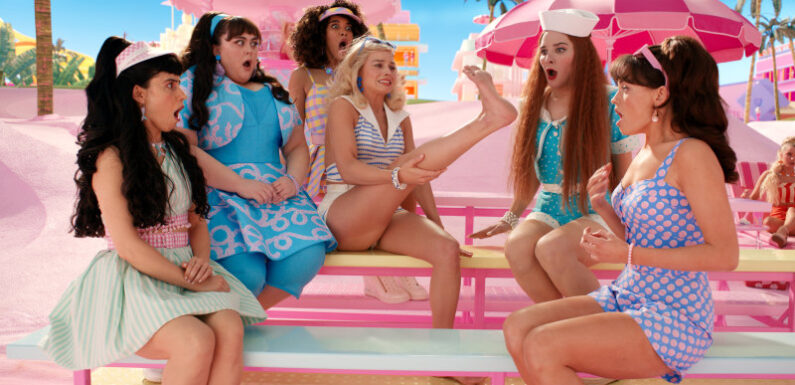
Save articles for later
Add articles to your saved list and come back to them any time.
If there were ever going to be political objections to the Barbie movie, you’d have thought they’d be on progressive grounds. First, the film was funded by Barbie manufacturer Mattel, representing a further step towards a capitalist cinematic hellscape where films are just feature-length advertisements, and there are no new ideas, only existing IP. Second, feminists have long-hated Barbie.
But since its box office record-breaking release, it’s the far right that has objected. Conservative commentator Ben Shapiro called Barbie “one of the most woke movies I’ve ever seen”. Fox News deemed the film “the ultimate virtue signal” and Twitter users accused it of being man-hating.
Virtue signaller or feminist icon? Credit: AP
Can the rumours be true? Has writer/director Greta Gerwig managed to convert Barbie, that paradigm of hypersexualised bimboism, into a feminist icon?
It would seem that the far right is too easily threatened. Yes, Barbie the movie has heard of feminism. (And thinks it sounds awesome!) But it doesn’t have anything too patriarchy-toppling to say about it.
The film follows the divergent paths of Stereotypical Barbie (Margot Robbie) and Beach Ken (Ryan Gosling) after they leave Barbie Land – where Barbies rule and Kens stand around waiting to be looked at – and venture into the real world.
Ken’s story, surprisingly, is the more coherent. In the real world, he’s thrilled to discover patriarchy. He returns his findings to Barbie Land, converting it into a utopia for incels, where the Barbies serve up beers and wait to have things Ken-splained to them. Eventually, order is restored, with Barbie apologising for ignoring him and acknowledging that Kens deserve some rights in Barbie Land.
Director Greta Gerwig and actor Margot Robbie in Sydney.Credit: Getty Images
The message here is a humanist one and certainly applicable to modern feminism. Any exercise of power, which depends on the powerlessness of others, is toxic, whether it’s wielded in ignorance (simply not noticing, Barbie-style, that Kens have feelings) or out of malice (Ken pushing the Barbies down to make himself feel bigger). True empowerment, Gergwig suggests, is in solidarity: helping others become more powerful.
The second story, Barbie’s story, is where any feminist messaging gets confused.
Margot Robbie’s Barbie is appalled to find that the real world, unlike Barbie Land, isn’t perfect. On the contrary, men jeer at her, teenagers don’t take her seriously, and there’s a constant undercurrent of sexual violence. But there’s also beauty in the imperfections: in the wisdom of old age, in mortality: the resonance of a life that’s necessarily fleeting. Although the real world has made her self-conscious and insecure, Barbie nonetheless chooses to stay there, trading a plastic fantastic life for a complicated, cellulite-riven human one.
It’s touching that Barbie might leave her pink toy box for a more emotionally rich reality. What’s less convincing, however, is the treatment of her “real-world insecurities”.
Margot Robbie meets fans at the Barbie premiere in London. Credit: Getty Images
To explain what Barbie’s going through, America Ferrera delivers a cumbersome monologue about how hard it is to be a woman in a society that constantly demands perfection. And just in case you’re not relating, there is a voiceover that quips: “Margot Robbie is not the best person to cast if you want to make this point.”
But the issue is not only that Robbie succeeds according to even the most unrealistic beauty standards (she looks like an AI-generated hot person). The issue is that she’s portraying Barbie – the doll that established those standards in the first place and then buried them in the psyches of millions of little girls.
In addition to being a doctor, or an astronaut, or a president Barbie has always been – and still is -ridiculously good-looking, thus restating in every iteration that women can be anything as long as they’re hot.
If Barbie dolls were merely beautiful objects (sparkly and symmetrical like a Furby or a Bratz doll) there wouldn’t be a feminist issue. The problem is, they’re beautiful, sexualised objects. Yes, Barbie doesn’t have genitals (as the film is at pains to remind us) but, with her pert breasts and her clean curves, she’s explicitly sexual, right from her very conception. (Barbie’s proportions were originally modelled off a lewd German doll, marketed to men and sold in tobacconists as a joke.) Whatever she wants or does, Barbie’s success is inseparable from her status as a passive, desirable object.
Ryan Gosling as Ken.
Gerwig acknowledges that Barbie dolls contribute to the pressures on women to satiate the male gaze. A woke teenager tells Barbie that she “makes women hate themselves” and at the end of the movie one character suggests Mattel release “an ordinary Barbie”.
But these instances are just lip service. Overwhelmingly, the film casts the dolls as tools for empowerment. When Robbie’s Barbie gets insecure, she never worries about her own role in perpetuating the very impossible standards she’s now so upset about. Ruth Handler, the inventor of Barbie, is depicted as a benevolent Creator. She gives Barbie her blessing to return to the real world and explains, very wholesomely, “I named you after my daughter.” She doesn’t add: “And then I modelled your body off a kinky German doll”.
Barbie isn’t interested in engaging deeply with, let alone rejecting, beauty standards. And why would it? It’s a film funded by Mattel. Beauty is their brand. All their Barbies are relentlessly good-looking. (Mattel has unveiled seven tie-in dolls to coincide with the film’s release; “Ordinary Barbie” is not among them).
Gerwig’s film aims no higher than cognitive dissonance. It nods at the impossible beauty standards that “make women hate themselves” but still wants to profit from them.
However, Gerwig seems to believe that cognitive dissonance is enough. In the film, all it takes to free the Barbies from Ken’s patriarchy is Ferrera explaining the double standards. In Barbie Land, articulating the problems with patriarchy equates to acting against it.
Unfortunately, Gerwig’s film was released in the real world, where pointing out the problems with a franchise such as Barbie doesn’t actually resolve any of them.
But perhaps this ironic, gestural activism (articulating double standards even while you reinforce them) is the feminism of our age. An age in which social media has the ability to make us more aware of social justice yet also makes us more conscious of our appearance than ever.. An age in which the biggest blockbuster of the year uses the word “patriarchy” more times than a First Year Gender Studies essay, and, at the same time, women are lining up at plastic surgeons to achieve Instagram Face.
When asked to describe her approach to Barbie, Gerwig said: “I’m doing the thing and subverting the thing”. That might also be an apt description of the very-online Modern Feminist. We’re all aware of the societal standards that oppress us, yet we embrace them. But ironically! We’re having fun with feminism, accessorising with it.
The question for Gerwig, and for feminists, is: how can you make a coherent statement if you’re always simultaneously subverting it? If Barbie the movie is anything to go by, the answer is: you can’t.
Find out the next TV, streaming series and movies to add to your must-sees. Get The Watchlist delivered every Thursday.
Most Viewed in Culture
From our partners
Source: Read Full Article
